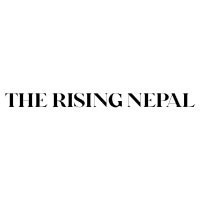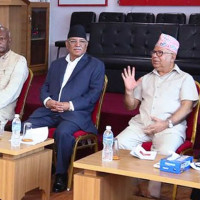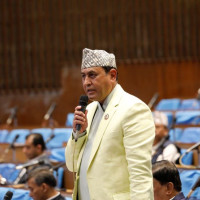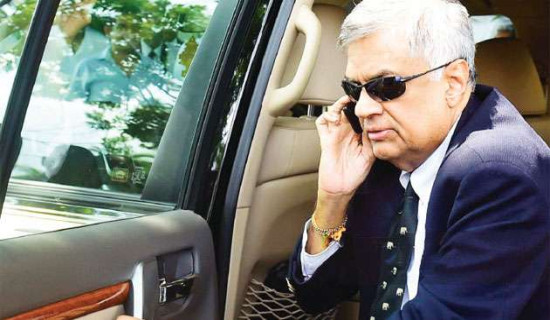- Saturday, 23 August 2025
Implications Of US's Strategic Shift To Asia
The pivoting of the US to Asia is caused more by its growing strategic significance and American aspiration to become the dominant power of this dynamic growth zone than its potential to unsettle the transition of world politics. US President Donald J. Trump’s persistent pursuit of strength, prosperity and peace aims to lay an edifice for America to be the global powerhouse ahead. The sovereignty-sensitive Asian nations are adjusting to the emerging global order. Political stability in the world in general and Asia in particular, however, requires both coordinated leadership of super powers and their matching responsibilities. It is not clear whether America’s pivoting to Asia is inspired by China’s inexorable rise with global initiatives or Russia’s pivoting to Asia following its confrontation with the Atlantic nations over its invasion of Ukraine for the latter’s interest to join NATO or pursue global peace by converting former adversary into friends, restart strategic arms limitation talk, avoid the risk of World War III.
Trade across the Asia-Pacific surpasses that of the Atlantic where the US has created naval, land and space deterrence. Asia has emerged as a hub of new technologies, manufacturing, youth bulge and entrepreneurship. It founded Panchsheel as a code of international relations. American Defense Secretary, Pete Hegseth, clearly stated in April that the US security priorities lie elsewhere — in Asia and on the US’s own borders — a shock to the European allies and other members of NATO. The USA’s minimalist European solidarity marks a maximalist shift to Asia. Both Europe and Canada are working on filling the security vacuum and even anticipating the American withdrawal of its troops and defense materials while opening to Asian nations in trade, investment and strategic partnership. They are planning to stem the negative effects of the resetting of US-Russia ties and the costs they have to bear with or without an America-brokered ceasefire and much-vaunted peace plan in Ukraine.
Collective self-defense
The recent statement of the US ambassador to NATO Matt Whitaker has indicated that under “President Trump’s leadership NATO will be more stronger and more effective than ever before, and I believe that a robust NATO can continue to serve as a bedrock of peace and prosperity” adding that “its vitality rests on every ally doing their fair share.” Upholding the doctrine of collective self-defense of trans-Atlantic nations, the US expects Europe to lead peace and security, rebuild Ukraine and take seriously the threat posed by China. The US is taking unilateral decisions and has shown little interest in multilateral institutions that Europe vouchsafed.
Its declining interest in the UN and its specialised agencies and worldwide imposition of tariffs show the erosion of the liberal global order set by the WTO. The America First and MAGA vision amount to economic mercantilism infecting the Asian industrial heartlands. President Trump’s administration has fired many security, aid and administrative officials to control the deep state agencies and restructure the security system. In a multipolar world order, the US is destined to play a mixed game of cooperation and conflict with diverse scales of Asian nations facing competitive security and development needs and embattled executives.
The zone of US priority: The US strategic priorities on Asia spouse Indo-Pacific region, South China Sea, Indian Ocean, Japan, Korean Peninsula and Taiwan. These priorities have bi-partisan consensus. U.S. Defence Secretary Hegseth’s first regional tour to Asia, notably to the Philippines and Japan, reiterated the continuity of U.S. bilateral and regional security commitments to AUKUS and QUAD and sought to modernise their defensive capacity to counter China. Japan is at the center of the American security system in Asia, with 55,000 active-duty soldiers here with a military based in Okinawa, 24,234 soldiers in South Korea and 9,000 troops under US Taiwan Defense Command. They share the defense burden with the US. Japan and Russia ties are marred by their dispute on Kuril Islands. Fearing North Korea, South Korea keeps balanced ties with the USA and China. The Philippines hosts five military bases. The Southeast Asian nations’ cooperation with China is growing but they prefer to stay away from choosing either the USA or China.
For the Indian Ocean and Persian Gulf, the US navy offers logistic support and operational forces to back its national goals. The US has performed missions in many nations, including India and Bangladesh, and strengthened defense ties with India while its Asia-Pacific Command holds annual military drills with member nations focusing on external threats. So long as the US is obsessed with the protection of its hegemony in the Western hemisphere and Middle East, it is less likely to stop the growth of Chinese power. Many Asian nations are defining their own political system rather than adopting the ideals of the US. Nations like Malaysia and Singapore defend Asian values while China prefers Asia for Asians, echoing past Indian and Japanese sentiments.
Yet China, India, Japan, South Korea, Vietnam, Indonesia and Singapore prefer liberal economic policies, which bolstered their muscle though differ in security frame. Both China and the USA do not want nuclear conflict and rely on international supply chains. The USA is less interested in ideological rivalry with its ideals of human rights, democracy and market economy with the Asian nations’ diverse cultural bents, such as China’s Confucianism, Japan’s Shinto Buddhism, India’s Hinduism, Indonesia, Malaysia and other Islamic nations’ Islam and Israel’s Judaism. The US even questioned the USAID’s role in converting Nepalis into atheism.
The US power has seen its limits in Vietnam, Afghanistan, Ukraine and the West Asian crises. The American economic and military aid to Israel to fight against all foraging states and non-state armed actors aspiring for Palestine statehood also displayed the limits of American primacy. The thorny geopolitics of Syria has brought Turkey-supported regime and Israel in stern row. Turkey is in a strategic partnership with China and buys arms and oil from Russia. The USA has invited Saudi economic investment. But it threatened Iran to accept its proposal to ditch nuclear ambition or face economic sanctions and attack. Both agreed to resume diplomacy, not conflict.
From strategic ambiguity to strategic Focus: The USA has eased China’s entry to all Western institutions while barring the then Soviet Union. It has maintained an ambiguous stand on Taiwan. It considers Taiwan a part of China but is critical of integrating it into China and stokes its aspirations for autonomy. But now, with the dramatic rise of China, the US is mobilising its alliance to contain it. China has an obvious lead in global trade with a surplus of $ 1 trillion after joining WTO while the US shows relative decline. It is progressing in AI, quantum computing, smart manufacturing, solar panels, batteries and production and supply of rare earth minerals.
China has 60 per cent of global EV production, 90 per cent of solar panels and 75 per cent of global battery production. Its large ship building capacity, with the modernisation of sea ports across various continents, is compatible with its global trade expansion. So does its progress in research, innovation and modernisation of the army. Growing ties of China with the Asian nations through Belt and Road Initiative (BRI) have offered it a large role in Central Asia, West Asia, South Asia and Southeast Asia.
Cooperation to competition: The USA’s protectionist policies and the imposition of tariffs worldwide to come out of its debt, declining economy, inflation and recession have caused global backlash, market turmoil and a tumbled shared market. It has alienated allies and competitors alike. Taiwan allocated $2.7 billion to help its industries hit by US tariffs. Japan deemed 24 per cent US tariffs a state of national crisis. India faces 26 per cent tariffs. Leaders from both nations are talking to their counterparts in the USA for damage control, not taking countermeasures. China is locked in reciprocal tariffs, fuelling the fear of global economic instability. It has announced control of rare earth materials while the US blocked the trade of sophisticated technologies.
BRICS's trade policy
BRICS nations are diversifying their trade to escape tariff walls and doing trade payments in their own currencies. BRICS, SCO, New Development Bank and Asia Infrastructure Investment Bank bring India and China together. Now, the share of US dollars in global reserves is 57 per cent. The other US strategy is to contain China through its Asian allies. The US has evolved a consultative mechanism with them, not acting unilaterally to aid its goals. It is rearming Japan, South Korea, the Philippines, Taiwan, QUAD and AUKUS members aiming to cut Chinese geopolitical heft spurred by its economy, investment, trade, modernisation of communication, transports and ports, building connectivity and developing hypersonic missiles to equip its army. President Trump is taking bold action to secure the national border and protect America by building the tariff walls, ending asylum for illegal migrants and cracking down on criminal sanctuaries.
An exercise in unilateralism: The unilateral suspension of US aid to small and poor nations of Asia for three months not only affected their infrastructure development but also health, education and social development. Now, the US thinks to apply its aid policy in a realistic perspective to promote its national interests. Accordingly, it exempted Taiwan, the Philippines, Israel and Egypt from the foreign aid freeze, putting them in high priorities. Japan, South Korea, India, Vietnam and Australia are less aggressive on tariffs. They are seeking a middle ground and adjusting with the tariffs rather than adopting countermeasures like China. The US security, tariffs and aid policies have increased cooperation among the Asian nations and beyond, prompting them to evolve a new multilateralism and alternative global order with its co-leadership and suggesting the US to forge cooperative international relations.
(Former Reader at the Department of Political Science, TU, Dahal writes on political and social issues.)

















